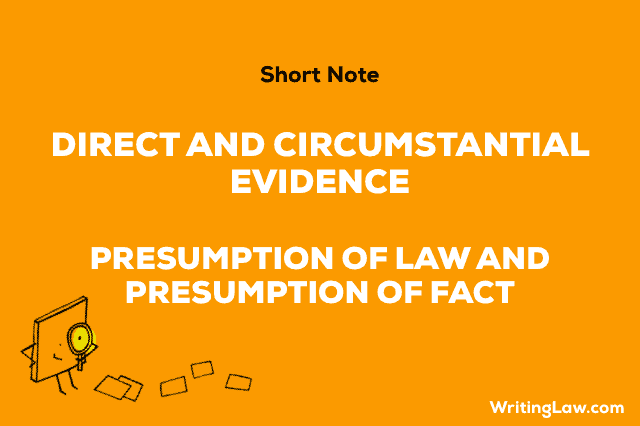Direct and Circumstantial Evidence
The Indian Evidence Act, 1872 talks about direct and circumstantial evidence. It is an essential to know the meaning and difference between direct and circumstantial evidence. This question was asked in Delhi Judicial Services Exam, 1973.
What is Direct Evidence in Law
It means any fact which without the intervention of any other fact proves the existence of a fact in issue.
Example, A is tried for causing grievous hurt to B with a club. C deposes (testifies) to the fact that he saw the accused, inflicting the blow, which caused the grievous hurt. The evidence adduced (mentioned, pointed out, cite as evidence) by C is direct evidence.
What is Circumstantial Evidence
It is that which relates to a series of facts other than fact in issue. This evidence assumes great importance when direct evidence is lacking.
The most fundamental decision on circumstantial evidence is, Hanumant Govind Nargundkar vs. State of MP.
J. Mahajan said that the circumstances should be of a conclusive nature and tendency. They should be such as to exclude every hypothesis, excluding the one proposed to be proved.
Difference Between Presumption of Law and Presumption of Fact
Presumption of Law
Presumption of law is based on provisions of law. There may be rebuttable presumption or irrebuttable presumption of law.
Rebuttable presumption of Law:
Example, A man is presumed innocent until proven guilty.
Courts can not ignore Presumption of Law. Presumption of Law is mandatory, and the court is bound to presume the same.
Irrebuttable presumption of Law:
Irrebuttable presumption can be found in section 82 of IPC wherein it is laid down that ‘nothing is an offence which is done by a child under seven years of age. No evidence will be allowed to be adduced that the accused was guilty’.
Example, A child born in legal wedlock shall be presumed to be legitimate, and the one who questions his legitimacy must disprove it.
Presumption of Fact
These presumptions are indicated in the act as ‘May Presume.’ These presumptions are based on the discretionary power of the court.
They are rebuttable as their evidentiary effect may be negated (invalidated, nullified, cancelled, make ineffective) by contrary proof.
Position of presumption of fact is uncertain and transitory. Court can ignore the presumption of fact even if it is strong. These presumptions are based on logic, the law of nature, and human experience.
- Article 334A of the Constitution of India - 14th April 2024
- Article 332A of the Constitution of India - 14th April 2024
- Article 330A of the Constitution of India - 14th April 2024








